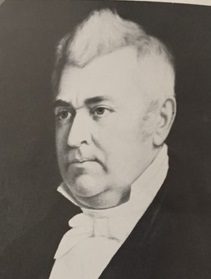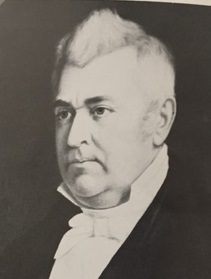by Terry Rogers


John M. Clayton, who grew up in Milford, served as Secretary of State under President Zachary Taylor
A statue of John M. Clayton stands at the United States Capital, donated to the National Statuary Hall Collection in 1934, stands today, yet very few are aware that his political career began in Delaware and that he was a resident of Milford for most of his life. Clayton had a long, rich political career that reached the national level, serving as Secretary of State under President Zachary Taylor.
The oldest son of James and Sarah Middleton Clayton, John Middleton Clayton, known as Jack, was born July 24, 1796, in Dagsboro. He was the nephew of Dr. Joshua Clayton who served as Chief Executive of Delaware under the Constitution of 1776. Of Quaker ancestry, it is believed the Clayton family came to America with William Penn and eventually found their way to Delaware. Clayton came from a long line of politicians with ancestors who served as continental senators, chief justice and a governor under the King of England.
From a young age, Clayton was an avid reader, and he developed a reputation as a fine speaker. He was sent to boarding school in Berlin, Maryland when he was old enough, but this school did not appeal to him as he claimed they did not serve enough food. He and James Davis, who was the son of Judge Isaac Davis, ran away from the school and walked to Milford where Clayton’s parents had just moved. His parents then sent him to school in Lewes before moving him the Old Academy in Milford.
The Clayton family resided in Parson Thorne Mansion which Clayton’s father purchased from Parson Sydenham Thorne’s nephew, Peter Caverly. While living in the mansion, Clayton would walk to visit his brother-in-law, Walter Douglass, who lived in Mordington on McColley’s Pond every Saturday, a distance of 16 miles.
Early on, Clayton impressed his teachers with his knowledge of politics. He was known to make political speeches from a stump in his father’s tanyard, giving him the reputation of being precocious. At the age of 15, he entered Yale and graduated four years later at the head of his class. He returned to Milford where he studied law with his cousin, Thomas Clayton before attending law school two years later in Litchfield, Connecticut.
After completing law school, Clayton returned to Delaware and opened a law office in Dover, building a very lucrative practice. However, politics continued to draw him and, in 1816, he was elected clerk of the House of Representatives while still attending law school. He served in that position in 1817 and again in 1819. He was clerk of the Senate in 1820 and served in that capacity until 1822. While serving as the clerk of the Senate, Clayton was appointed Auditor of Accounts in 1821. From 1824 to 1828, he served as Delaware’s Secretary of State and, in 1826, he was elected to the State House of Representatives.
In 1822, Clayton married Sally Ann Fisher and they had two children. Sally passed away in 1825, one year before Clayton was elected to the Delaware Senate. John Comegys wrote that after his wife died, Clayton seemed to have no “attractions, but for the necessity of taking care of those who had been committed to him before and the children his wife had given him, he would have sunk, utterly, under the load of his affliction.” Clayton often said that work in his profession saved him after the death of his wife.
Clayton was elected to the United States Senate in 1828, the youngest in that session and was re-elected in 1834 but resigned in 1836 to return to Delaware in order to focus on his law practice and his children. His love of walking continued as he was known to walk the six miles from his home to the Dover Courthouse each day, acknowledging and speaking to those he met on the way. In 1837, Clayton was appointed Chief Justice of the Supreme Court of Delaware, serving for two years before retiring again. He received an honorary doctorate from Yale in 1836.
After his retirement, Clayton moved from Dover to New Castle in 1842, living in the Read Mansion until he built Buena Vista. National politics called to him again in 1842 and he was elected to the Senate. As a Delaware legislator, Clayton was instrumental in building the first railroad in the state.
Due to his popularity in the Mexican War, General Zachary Taylor was elected president in 1848, Although President Taylor never declared for any party, it was believed he was a Whig, the precursor to the Republican party. There are reports that President Taylor had never voted and when the notice was sent to him that he had been nominated, he refused to accept it because it did not have enough postage. After his election, President Taylor held his military command until January 1849 and kept his cabinet choices quiet. When he did choose his cabinet, he did not choose prominent Whigs, but instead chose people he felt he could trust.
His first choice for Secretary of State was Governor John Crittenden of Kentucky, but Crittenden did not want to resign as governor. President Taylor then chose Clayton. The two men met less than two weeks before his inauguration. Both men had little diplomatic experience, but they had similar nationalism sentiments. President Taylor allowed Clayton to handle foreign policy matters with little interference from him. Clayton, as well as President Taylor, were opponents of the European political order and supported German and Hungarian revolutionaries.
Throughout 1849 and 1850, a Venezuelan radical, Narciso Lopez, led repeated expeditions to Cuba in an attempt to conquer the island. Clayton saw the enterprise as illegal despite Lopez’s attempts to gain American support. President Taylor and Clayton issued a blockade and authorized the arrest of Lopez and his followers. At the same time, the Taylor administration, led by Clayton, confronted Spain about Americans who had been arrested for piracy. Spain released them to keep good relations with America.
The construction of a canal through Central America was a cause of tension between Britain and Nicaragua. Britain had been seizing points on the eastern coast of Central America. Negotiations were held, resulting in the Clayton-Bulwer Treaty in which both nations agreed not to claim control of any canal built in Nicaragua and guaranteed neutrality in lines of travel across Central America’s Panama isthmus. The treaty laid the groundwork for the building of the Panama Canal.
President Taylor died on July 9, 1850, of cholera, just over a year after taking office. Clayton resigned his position in the cabinet intending to return to his law practice. In 1853, he was once again elected to the United States Senate. During his campaign, Minnesota Senator Lewis Cass claimed that the Clayton-Bulwer Treaty was not in the best interest of the country. Because he had not been elected, Clayton refused to respond, stating that he was a private citizen. However, in his opening address as a Senator, Clayton responded the Minnesota Senator, putting his reputation on the line and many say he gained the respect of the Senate for being honest and forthright.
As a Senator, Clayton served with such greats as Henry Clay, Daniel Webster and John C. Calhoun. It was during his term in office that the Missouri Compromise was passed and Clay stated that it would “not have been possible without his efforts.”
Clayton died on November 9, 1856, during a recess of Congress. Senator Crittenden said at his death “I will not attempt any deration of the character of Mr. Clayton, or an enumeration of his public services. These belong to history. But we who were his associates, who saw and knew, and heard him, can bear witness that he was a great man and a great statesman, of unsullied and unquestioned patriotism and integrity and that in the Senate and in the Cabinet, he rendered great service to his country. If history be just to him, she will gather up all these materials, and out of them she will mould for him such a crown as she awards to great and virtuous statesmen who serve their country and well.”
In recognition of his service to the country, the statue of Clayton was placed in the rotunda of the nation’s Capitol on June 26, 1934, joining Caesar Rodney, a signer of the Declaration of Independence. Clayton and his wife are buried in a private cemetery on the grounds of the Parson Thorne Mansion
RELATED STORIES:
Share this Post



